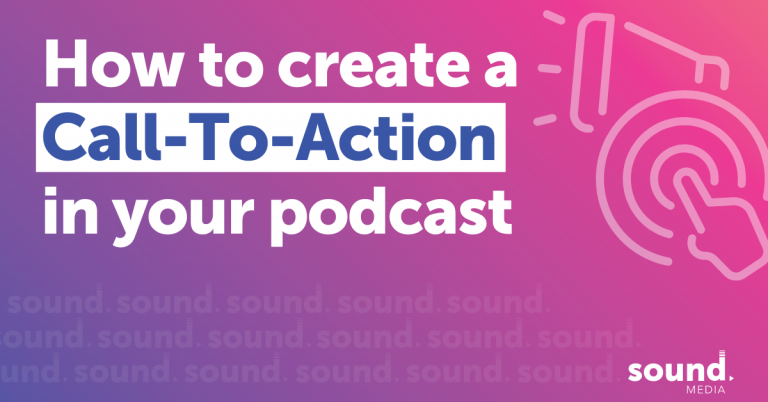‘Send no money now’
I haven’t heard that phrase in a long time, but in the not too distant past, this was a regularly used Call To Action (CTA) on TV and magazine ads.
It was way before the days of the internet, email, social media or just about any useful technology that we now use day to day.
But it really sticks in my mind. Even back then I found it a strange CTA, and I didn’t even know what CTAs were.
Thankfully nowadays, we understand effective CTAs much better, and we no longer ask people to not send any money now (even typing that makes my head hurt).
Podcasts are a particularly good platform for a CTA. With a podcast, you’re talking directly to someone – not a link on their feed or a video on their screen. It’s just your words going straight from your mouth into their ears. If you can visualise that, you can start to see just how unique podcast CTAs are.
It’s fairly clear to see how simple CTAs work. Something like ‘hit follow to get our new episodes first’ or ‘find us on social media’ are as basic as they get.
But as a brand, you’re likely to want something a bit more specific. Make this a really clear part of your podcast strategy – exactly what your CTA is. It might be slightly different to what you use elsewhere, in order to make the most effective use of the uniqueness of podcasting as we mentioned above.
You might have more than one CTA, but it’s advisable to keep it to a couple within an episode so it doesn’t start to feel too top-heavy. Bear in mind the more CTAs you rotate, the more watered down those messages become. Often, less is more – a single CTA you can really hammer home is likely to be more successful than several mixed in together.
What works?
It could be a simple directional message – go to our website to find out more, sign up for our newsletter, book in a call / free review – etc.
But it could also be something a little more complex. It could be pointing people to a lead magnet. Have a read of this to go a little further into how that works.
I mean really, your CTA can be anything, but the important thing is for it to be well thought out and something that fits in with your wider business goals and objectives.
Whatever it is, you do need to think about the most effective way of using your CTA within your podcast. They don’t all work the same. Some you can just mention as a web link or a social handle, but others will need to be worded right in order to make the message clear. If you’re saying something like ‘please rate and review the podcast’ is that enough? I’d argue these are just words – you need to give more clarity on what you want someone to do.
Follow not subscribe
Stay away from the phrase ‘subscribe to the podcast’. Yes, it is traditionally what podcasters have said and yes, most listeners understand what it means in a podcast context. But it’s a word which has heavy connotations of a) cost and b) commitment which aren’t accurate here.
Also remember that everyday, someone becomes a podcast listener for the first time. How amazing would it be if your podcast is the first they listen to?! But also bear in mind that what we’ve just said about ‘most listeners’ understanding what we mean by subscribe doesn’t apply in this case. Someone new to podcasting could well apply a more general understanding to ‘subscribe’ and be put off.
Most podcast apps now have a ‘Follow’ button rather than subscribe, and that’s much better phrasing to use.
How should it sound?
There are a few options but here are the main ones:
1. Pre-produced trail – maybe right at the start of your podcast, effectively running as a pre-roll advert where you sell the CTA and tell people where to go
2. Presenter-read trail – this could be at the start, in the middle, or at the end, or a couple of these places. It’s not pre-produced, but it is scripted.
3. Organic presenter mention – similar to above, but worked more cleverly into the episode. This needs more planning, so that you reach a point in the episode where you are discussing a subject which leads organically onto your CTA.
Use the show notes
Whatever your call to action, however you phrase it within your episodes, use the show notes effectively.
We’d all love to think that our audience stops what they’re doing, locks themselves in a room, and listens attentively to our episodes without a single distraction.
The reality is that usually people consume podcasts on the go. Out for a walk, at the gym, in the car, on the train, making dinner – you get the idea.
Therefore they’re probably going to struggle to immediately type in your web address or even make a note of it somewhere. Unless it’s incredibly easy to remember, you need back-up.
Your show notes allow you to include clickable links and where appropriate, more information around your CTA.
They could expand on it – let’s say that in your CTA you point people to your website for more information on a topic. You could also say that in the show notes are links to blogs about X, Y and Z which are super relevant to what your episode is discussing.
You might not even bother reading a link out on the podcast itself, and instead just put it in the show notes. If you’re inviting people to book a call with you, use the episode to sell the benefits of that call, and then just push people to the link in the notes.
But remember – be strategic
At every step, bring it back to your initial strategy. You’re doing this for your business to grow, and so sticking to your goals is key.
If you’re ready to make the step into the podcasting world for your business, we’d love to help you. Get in touch and let’s chat.



